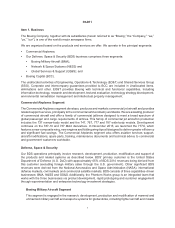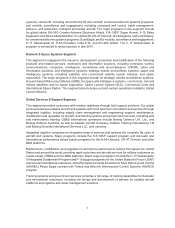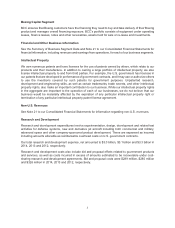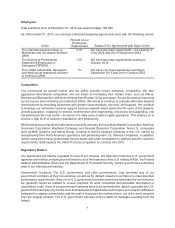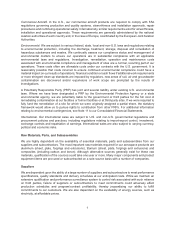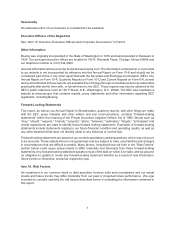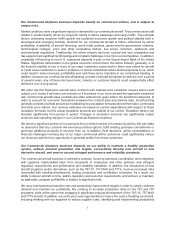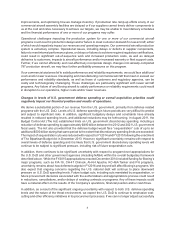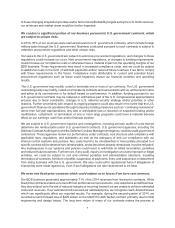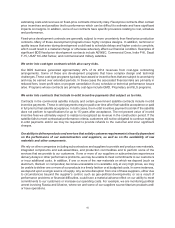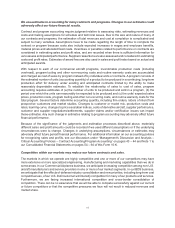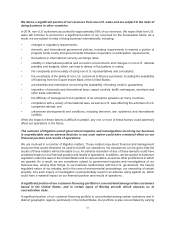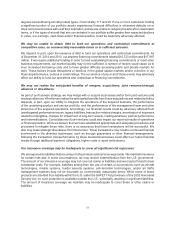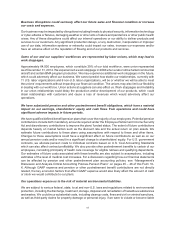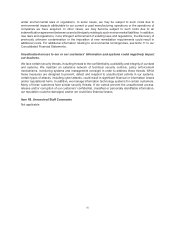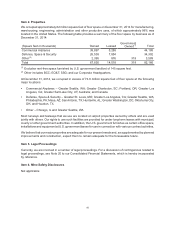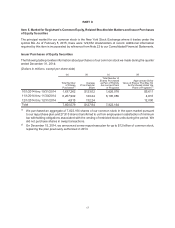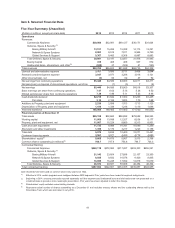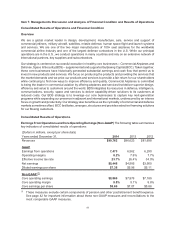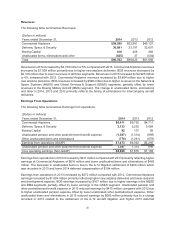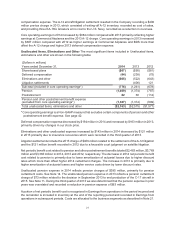Boeing 2014 Annual Report Download - page 23
Download and view the complete annual report
Please find page 23 of the 2014 Boeing annual report below. You can navigate through the pages in the report by either clicking on the pages listed below, or by using the keyword search tool below to find specific information within the annual report.11
We use estimates in accounting for many contracts and programs. Changes in our estimates could
adversely affect our future financial results.
Contract and program accounting require judgment relative to assessing risks, estimating revenues and
costs and making assumptions for schedule and technical issues. Due to the size and nature of many of
our contracts and programs, the estimation of total revenues and cost at completion is complicated and
subject to many variables. Assumptions have to be made regarding the length of time to complete the
contract or program because costs also include expected increases in wages and employee benefits,
material prices and allocated fixed costs. Incentives or penalties related to performance on contracts are
considered in estimating sales and profit rates, and are recorded when there is sufficient information for
us to assess anticipated performance. Suppliers’ assertions are also assessed and considered in estimating
costs and profit rates. Estimates of award fees are also used in sales and profit rates based on actual and
anticipated awards.
With respect to each of our commercial aircraft programs, inventoriable production costs (including
overhead), program tooling and other non-recurring costs and routine warranty costs are accumulated
and charged as cost of sales by program instead of by individual units or contracts. A program consists of
the estimated number of units (accounting quantity) of a product to be produced in a continuing, long-term
production effort for delivery under existing and anticipated contracts limited by the ability to make
reasonably dependable estimates. To establish the relationship of sales to cost of sales, program
accounting requires estimates of (a) the number of units to be produced and sold in a program, (b) the
period over which the units can reasonably be expected to be produced and (c) the units’ expected sales
prices, production costs, program tooling and other non-recurring costs, and routine warranty costs for the
total program. Several factors determine accounting quantity, including firm orders, letters of intent from
prospective customers and market studies. Changes to customer or model mix, production costs and
rates, learning curve, changes to price escalation indices, costs of derivative aircraft, supplier performance,
customer and supplier negotiations/settlements, supplier claims and/or certification issues can impact
these estimates. Any such change in estimates relating to program accounting may adversely affect future
financial performance.
Because of the significance of the judgments and estimation processes described above, materially
different sales and profit amounts could be recorded if we used different assumptions or if the underlying
circumstances were to change. Changes in underlying assumptions, circumstances or estimates may
adversely affect future period financial performance. For additional information on our accounting policies
for recognizing sales and profits, see our discussion under “Management’s Discussion and Analysis –
Critical Accounting Policies – Contract Accounting/Program Accounting” on pages 43 – 44 and Note 1 to
our Consolidated Financial Statements on pages 54 – 64 of this Form 10-K.
Competition within our markets may reduce our future contracts and sales.
The markets in which we operate are highly competitive and one or more of our competitors may have
more extensive or more specialized engineering, manufacturing and marketing capabilities than we do in
some areas. In our Commercial Airplanes business, we anticipate increasing competition among non-U.S.
aircraft manufacturers and service providers in one or more of our market segments. In our BDS business,
we anticipate that the effects of defense industry consolidation and new priorities, including long-term cost
competitiveness, of our U.S. DoD customer will intensify competition for many of our products and services.
Furthermore, we are facing increased international competition and cross-border consolidation of
competition. There can be no assurance that we will be able to compete successfully against our current
or future competitors or that the competitive pressures we face will not result in reduced revenues and
market share.


